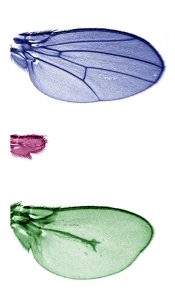The Drosophila fly brings to light the role of morphogens in limb growth
Posted by IRBBarcelona, on 5 July 2017

• Scientists at IRB Barcelona clarify the function of the genes that drive wing development in the fruit fly Drosophila melanogaster.
• Published in the journal eLife, this study unveils that the Dpp morphogen is necessary for wing growth but that its gradient does not govern this process.
• Understanding the development of limbs in Drosophila paves the way to research into congenital defects in vertebrates.
Barcelona, 5th July 2017.- Researchers working in the Development and Growth Control Lab at IRB Barcelona reveal that the Dpp gene (BMP in humans) plays a double role in the structural organisation and growth of the wings of the fruit fly Drosophila melanogaster.
This study, which has been published in the journal eLife, demonstrates that Dpp is necessary for tissue growth but that “its gradient does not direct wing growth,” explains Marco Milán, ICREA research professor and head of the study. This and two other studies published simultaneously in the journal eLife settle the intense scientific debate regarding the function of Dpp and other morphogens involved in development.
Morphogens are molecules found in concentration gradients throughout tissues and they send signals from one cell to another. “The wing of Drosophila melanogaster has several morphogens, such as Dpp (BMP in humans) and Wingless (Wnt in humans), which are necessary for growth,” explains Lara Barrio, the first author of the study and postdoctoral fellow in the Development and Growth Control Lab at IRB Barcelona. In this study, the scientists have examined how Dpp regulates growth and analysed how cells behave when Dpp levels are manipulated.
The role of the Dpp concentration gradient in the regulation of tissue is the subject of intense debate among scientists. Morphogens have been considered to be responsible for this process; however, using distinct techniques, these three studies now conclude that morphogens are necessary for growth but that their concentration gradients do not directly govern this process.
“We know that the gradient of this morphogen in particular affects the structural organisation or the identity of the tissue, but the different levels of Dpp across the tissue have no effect on growth. That is to say, whether a tissue grows or not depends on whether Dpp is present or absent. Its gradient has no influence”, explains Marco Milán.
So what regulates the size of the final structural of the Drosophila wing? “Morphogen gradients don’t. There must be another alternative and as yet unknown mechanism, and the fly wing is an ideal model to answer this question,” says Marco Milán.
This research is consistent with knowledge about the morphogen Sonic hedgehog in vertebrate limbs. The gradients of this molecule affect tissue identity (for example, for the fingers of a hand to differ from each other) but do not regulate growth. Therefore understanding how the structures of Drosophila form and develop paves the way to studying vertebrate development and congenital defects in humans.
This study has been supported by the Ministry of Economy, Industry and Competitiveness (MINECO), ERDF “Una manera de hacer Europa”, and the CERCA Programme of the Government of Catalonia.
Reference article:
Lara Barrio and Marco Milán
Boundary Dpp promotes growth of medial and lateral regions of the Drosophila wing
eLife (2017). DOI: 10.7554/eLife.22013


 (No Ratings Yet)
(No Ratings Yet)
See also Markus Affolter, Konrad Basler and Jean-Paul Vincent’s papers on the same topic in eLife.